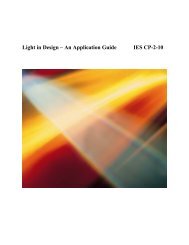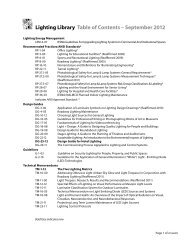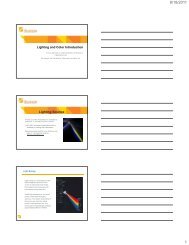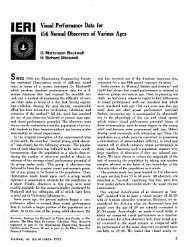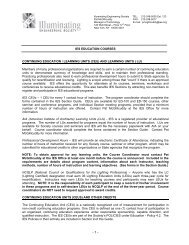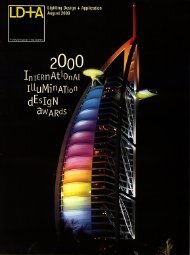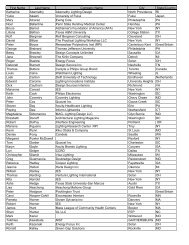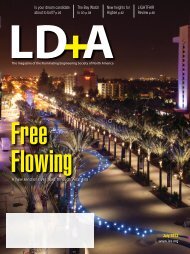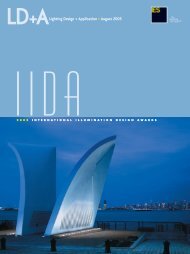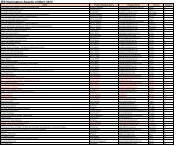light products - Illuminating Engineering Society
light products - Illuminating Engineering Society
light products - Illuminating Engineering Society
You also want an ePaper? Increase the reach of your titles
YUMPU automatically turns print PDFs into web optimized ePapers that Google loves.
. . . . . . . . . . . . . . . . . . . . . . . . . . . . . P R. O. J . E C. T . . . . . . . . . . . . . . . . . . . . . . . . . . . . .<br />
The upper level with the Buddha and stupas would be illuminated to 350 to 400 lux, approximately eight times brighter than the lower walls.<br />
civilization in Java. The highest level is split into four sublevels<br />
where there are 72 bell-shaped stupas located in<br />
four concentric rings.<br />
With all of the walls containing carvings and Buddha<br />
statues it became apparent that the temple needed a special<br />
kind of <strong>light</strong>ing. To create a three-dimensional shape,<br />
the <strong>light</strong> would need to come at 45 deg angles and not<br />
The main stipulation for any<br />
<strong>light</strong>ing design was the fixtures<br />
had to be mounted on poles,<br />
hidden from day<strong>light</strong> view by trees<br />
straight on. After studying pictures of the temple, it was<br />
determined that angular key <strong>light</strong> would best bring out<br />
the vertical lines of the wall carvings and the protruding<br />
steps on each of the sides.<br />
To best achieve the angles of <strong>light</strong> near the middle<br />
stairway, the fixtures were located on the opposite side of<br />
the center pathway, so the <strong>light</strong> crossed sideways over<br />
the center path in a cross-fire pattern. Each cross-fire<br />
pole was located approximately 28-32 ft from the center<br />
walk. There are a total of eight cross-fire poles illuminating<br />
the four slanting pyramidal faces.<br />
The biggest problem was the distance from the pyramid<br />
face. The flat, bare apron varied in the distance from the<br />
tree line to the temple. Borobudur is a symmetrical structure<br />
with asymmetrical pole locations, so if the <strong>light</strong>ing<br />
output from each was equal then the effective illumination<br />
on the temple would be unequal. To compensate for this,<br />
four, 400-W MH fixtures on the close cross-fire poles (east<br />
and west sides) six, 400-W on the north side and eight,<br />
400-W on the south side were part of the design.<br />
The PF400 fixture was selected to do most of the crossfire<br />
work. The 3x2 beam optic pushed a soft spot of <strong>light</strong><br />
onto the walls of the pyramid 80 to 120 ft away without<br />
making hot spots. For the longer distance positions on<br />
the far corners of the south and north sides, two 400-W<br />
1x1 stadium <strong>light</strong>s were used on each of the cross-fire<br />
poles. The fixture height on the cross-fire poles was set at<br />
12 meters above the apron level to get all the cross-fire<br />
fixtures above a horizontal ledger line at the second level.<br />
However, each pole length had to be adjusted to the varying<br />
height of the footing below the apron grade. The<br />
result of the <strong>light</strong>ing was not only vertical shadowing of<br />
the wall carvings from the cross-fire technique, but a horizontal<br />
shadow line accenting the second level as the fixtures<br />
created down<strong>light</strong>ing over the ledge.<br />
The fill <strong>light</strong> used to cut the shadows from black to gray<br />
was accomplished by reusing the existing 1000-W quartz<br />
fixtures that had previously been installed. The quartz fixtures<br />
were located near the corners and aimed back<br />
54 www.iesna.org



